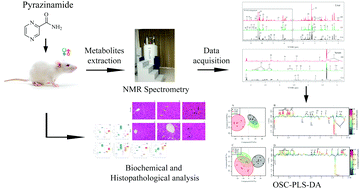Pyrazinamide-induced hepatotoxicity and gender differences in rats as revealed by a 1H NMR based metabolomics approach†
Abstract
Pyrazinamide (PZA) is a well-known first line anti-tuberculosis drug used in combination with other drugs such as isoniazid and rifampicin. Unfortunately, PZA suffered from a high rate of hepatotoxicity and hyperuricemia, which has not been clearly elucidated, hindering its wide application for therapeutic purposes. The purpose of this investigation was to develop a model of rat sub-acute hepatotoxicity induced by PZA and to explore the affected metabolic pathways by a 1H NMR-based metabolomics approach complemented with histopathological analysis and clinical chemistry. Rats of both genders were administered with PZA by gavage at doses of 1.0 and 2.0 g kg−1 for 4 weeks. PZA decreased the weights of dosed rats and induced liver injury dose-dependently. The female rats were more sensitive to PZA induced damage. Orthogonal signal correction partial least-squares discriminant analysis (OSC-PLS-DA) of the NMR profiles of the rat liver and serum revealed that PZA produced a status of oxidative stress and disturbances in purine metabolism, energy metabolism and NAD+ metabolism in a gender-specific and dose-dependent manner. These findings could be helpful to clarify the mechanism of PZA-induced hepatotoxicity and hyperuricemia. This integrated metabolomics approach showcased its ability to characterize the global metabolic status of organisms, providing a powerful and feasible tool to probe drug induced toxicity or side effects.

- This article is part of the themed collection: Toxicology Research 2017 Most Downloaded Articles

 Please wait while we load your content...
Please wait while we load your content...